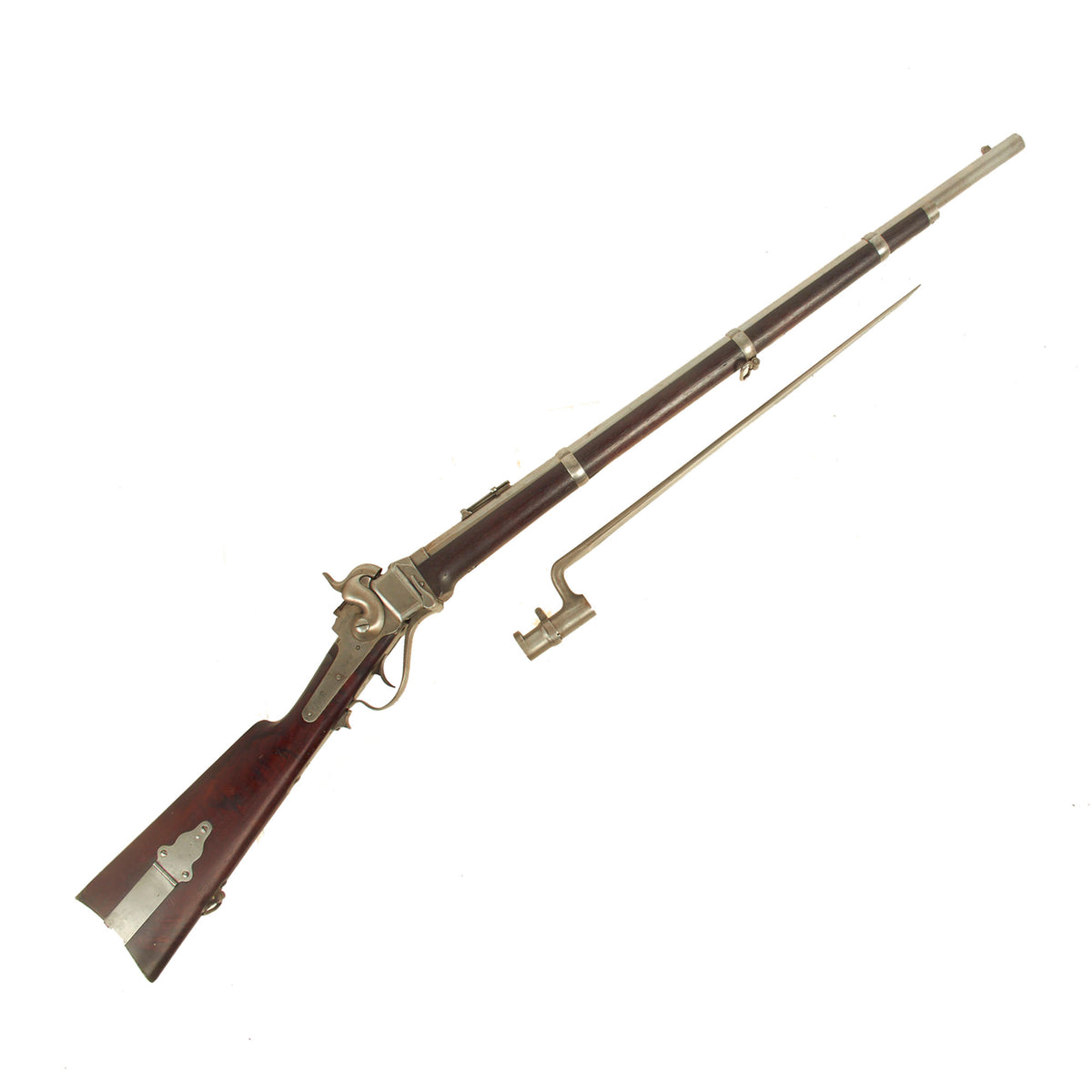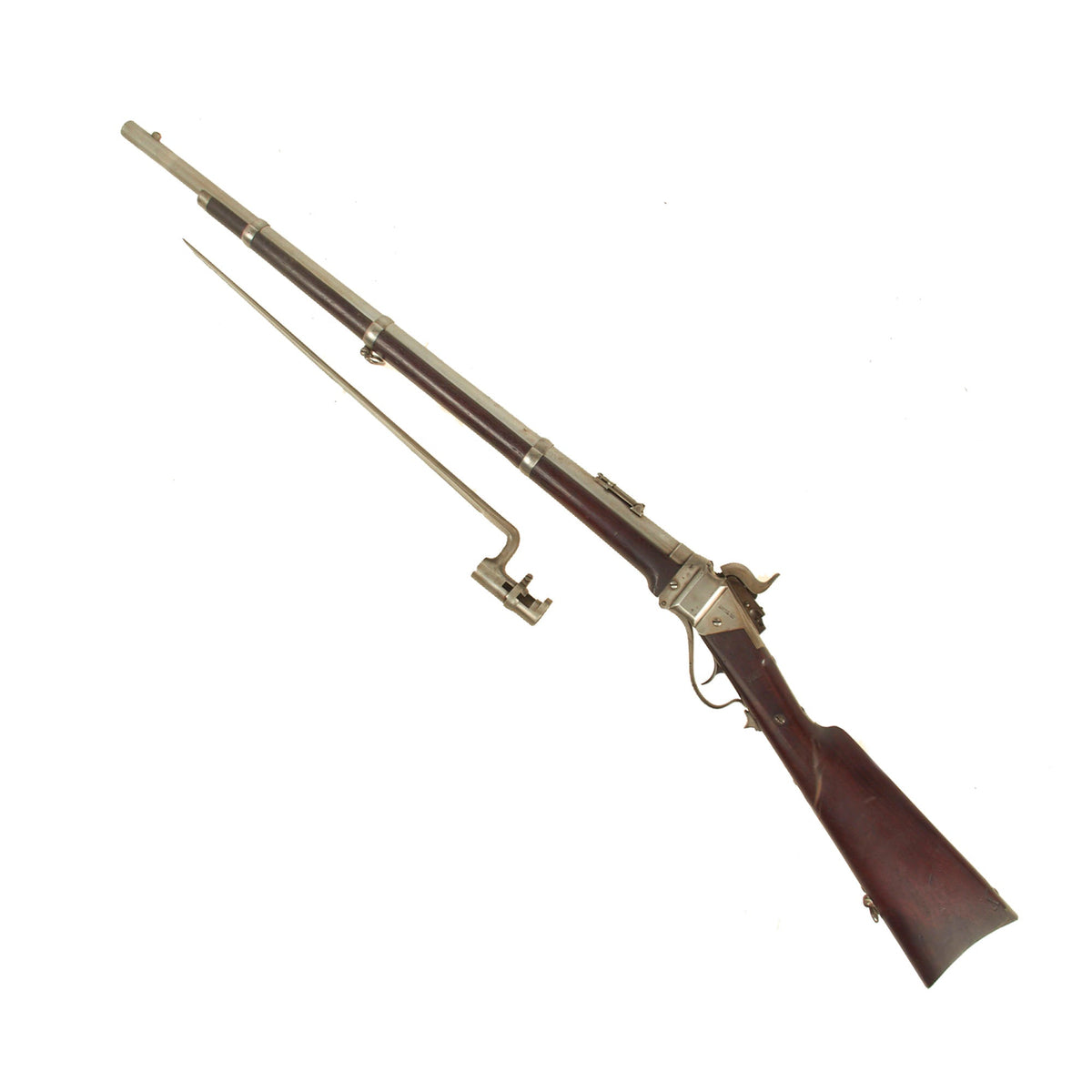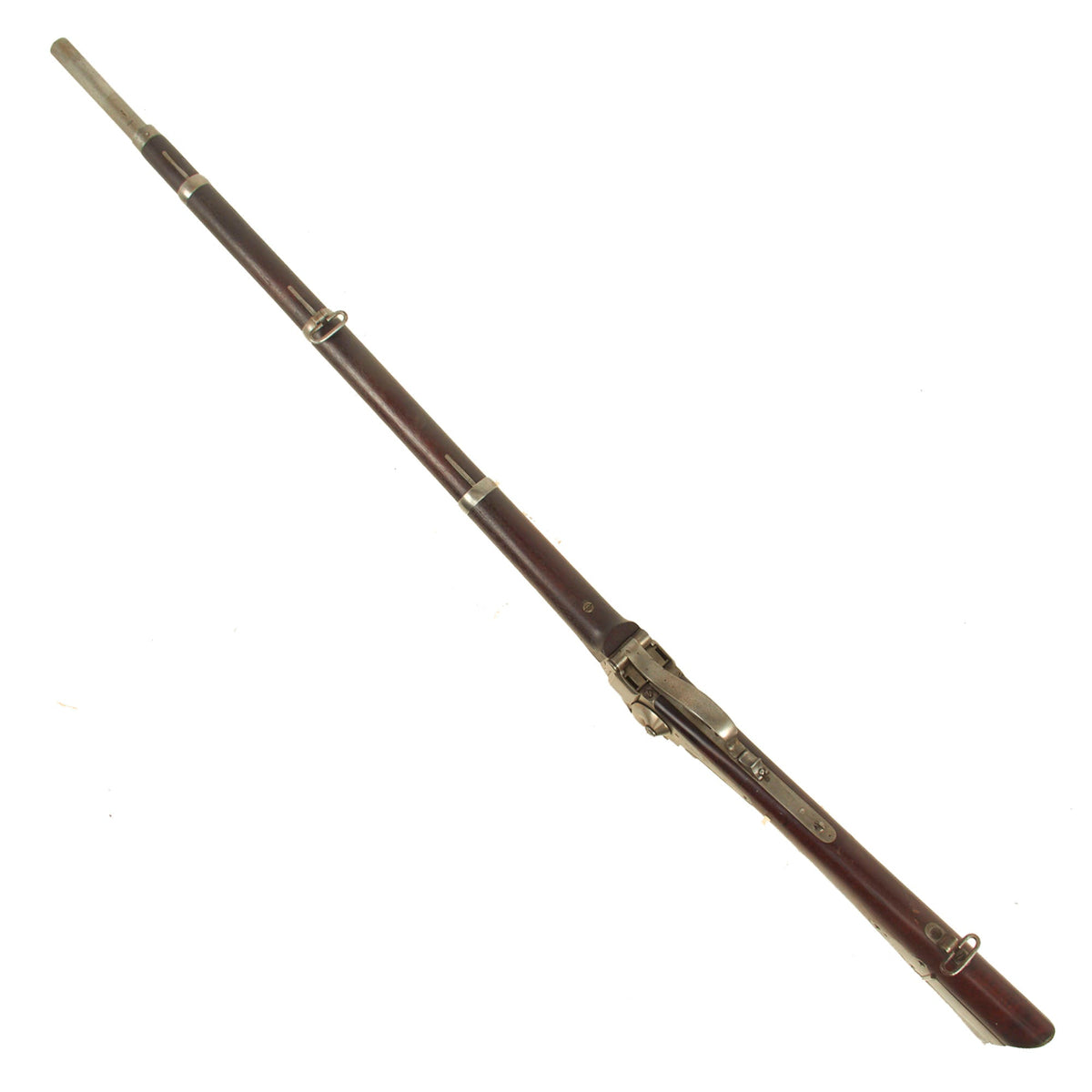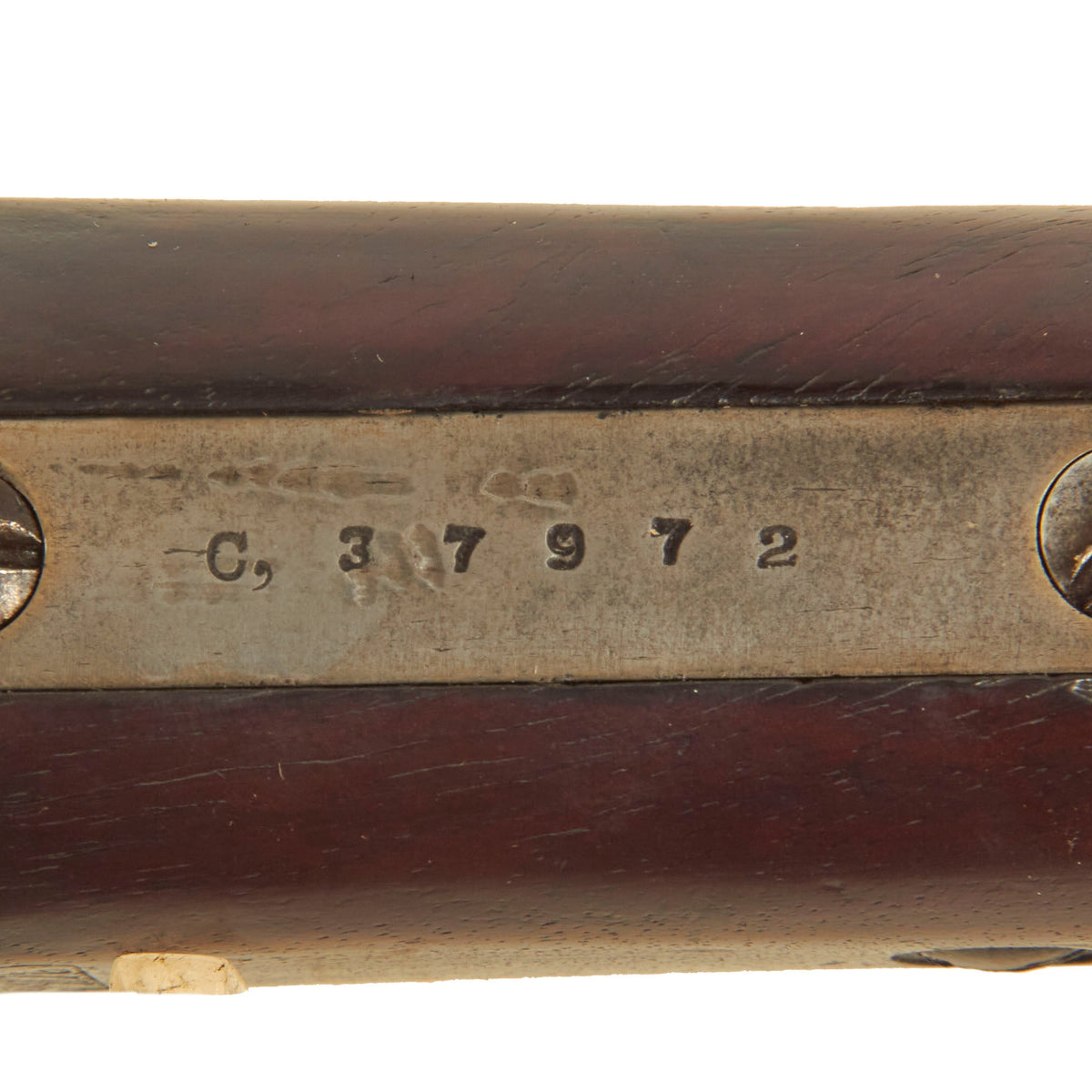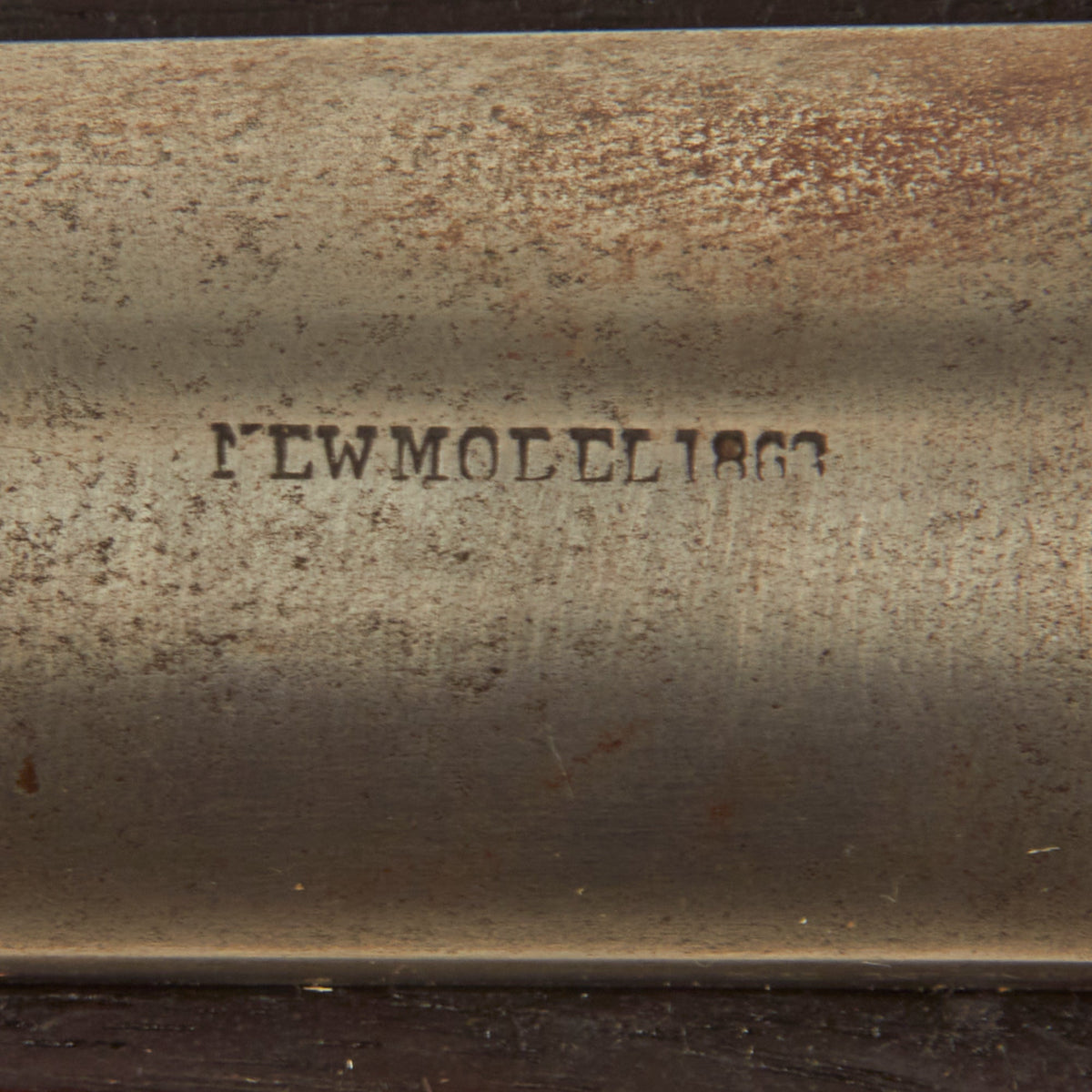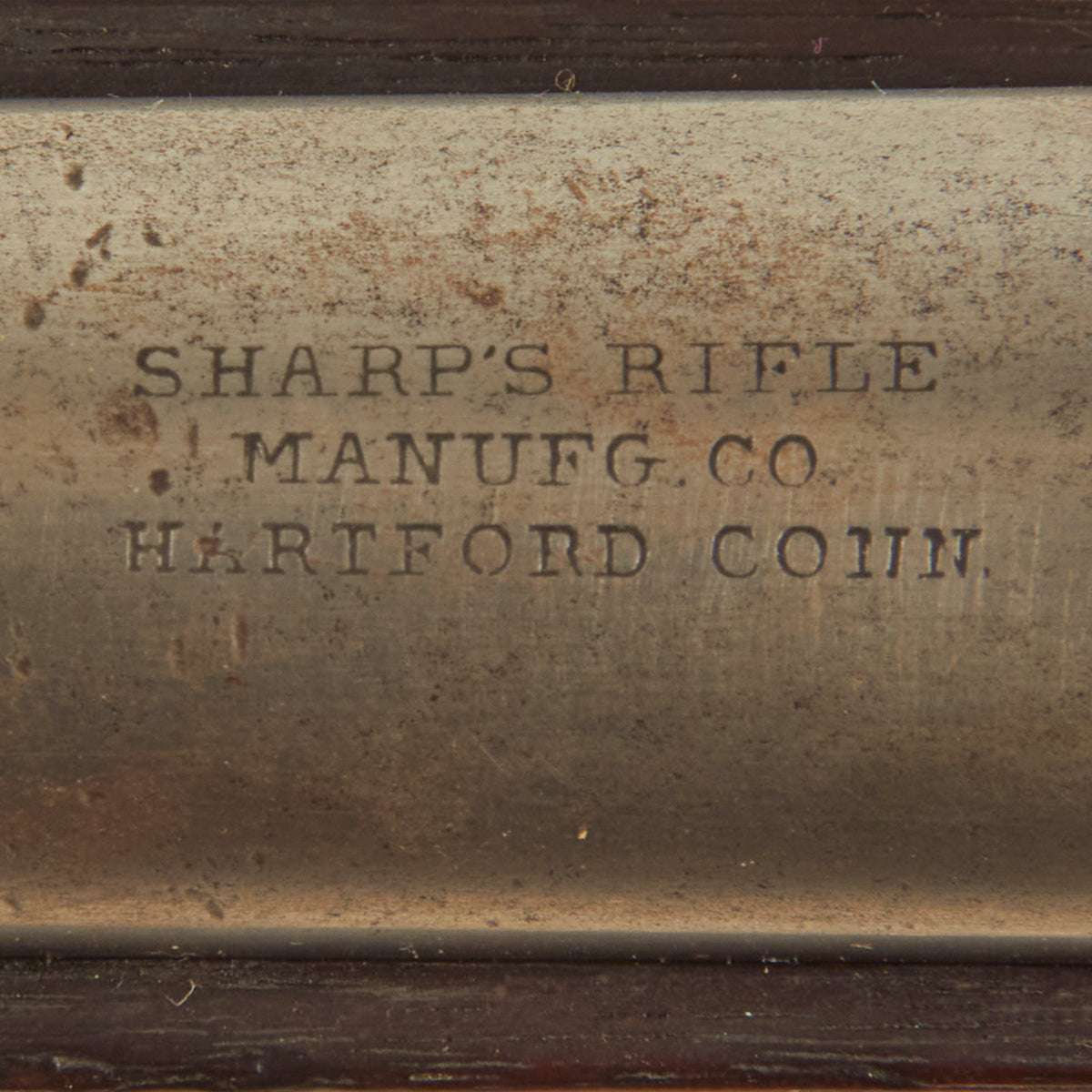Original Excellent U.S. Civil War Sharps Vertical Breech New Model 1863 Military Rifle with Bayonet and Tool – Serial C,37972 Original Items
$ 4.995,00 $ 1.248,75
Original Item: Only One Available. This is an excellent example of an original New Model 1863 Military Vertical Breech 3-band Rifle in the original .52 caliber, serial number C,37972, which was Sharps way of writing 134,747. (C is the Roman Numeral for 100,000). This model features a later version of the Sharps action with an improved gas seal and vertical breech. The long rifle type was made in far smaller numbers than the carbine, so finding them is quite rare, and we believe this is only the second example that we have ever had! Even better, it comes complete with an original bayonet, as well as the original action tool it was issued with! This is a fantastic offering!
The metalwork on the rifle is in really great shape, with decades of cleaning having worn the finish to a lovely bright steel patina. We do not see signs of any major rust issues in the past, or refinishing, and the markings are still all present and crisp. The bore is in very good condition, with clear 6 groove rifling and a bright finish. It does show wear from use and past cleaning, but we usually see these close to shot out or rusted solid, so this definitely ranks as one of the better bores.
The falling block action lent itself to conversion to the new metallic cartridges developed in the late 1860s, so many were converted in the late 1860s and were used during the Indian Wars in the decades immediately following the Civil War. This rifle however was not converted, and is still in the original configuration.
Clear markings on the lock plate read-
R.S. LAWRENCE PAT
APRIL 12TH 1859
C. SHARPS’ PAT
OCT 5TH 1852
The left side of the receiver is marked-
C.SHARPS PAT
SEPT 12TH 1848
Markings on the barrel read by the chamber end-
NEW MODEL 1863.
The barrel is also marked in front of the sight:
SHARPS RIFLE
MANUFG. CO.
HARTFORD CONN
The rear sight bed is marked:
R.S. LAWRENCE
PATENTED
FEB 15TH 1859
Clear serial number is marked on the receiver tang-
C,37972
We checked under the fore stock, and barrel is matching numbered, and shows no signs of being messed with. The left side of the barrel is marked with M.N.M., the initials of Moses N. Marshall, a known inspector of Sharps rifle & carbine barrels. There is unfortunately not much information on the total production or serial numbers of the Model 1863 rifles, so we are not able to tell exactly when this was made. If they use the same sequence as the carbines, it was probably made in late 1864 or early 1865
The walnut wood stocks are in truly fantastic condition, showing just a bit of wear and some dents, and showing great grain with a fantastic aged red brown color. The butt stock also shows some great figuring on the fight side. We do not see any repairs in the stocks, and they have never been restored or subjected to any major cleaning. This means that the original stock cartouches are still FULLY visible, and they are really something! The rear bottom of the fore stock is stamped with A.W.M., which is also present on the top of the butt stock just in front of the butt plate tang. Additionally there is a boxed script AWM cartouche on the left side of the butt stock, and all of these are for civilian sub-inspector Allen W. Mather, a known inspector of Sharps rifles and carbines. There is also the boxed script TWR for civilian Ordnance Department sub-inspector Thomas W. Russell.
The patch box opens smoothly and in general the rifle is in sound condition. This rifle was set up to use the tape primer system, which is built into the lock, however it has been disconnected, as many were. The action is tight, and cycles correctly, with the condition of the cap nipple suggesting moderate use while in service.
The included bayonet is in very good condition, and like the rifle, has a lovely polished steel patina, with just a bit of overall oxidation. It fits the rifle well, and really adds to the piece. The multi-tool is the icing on the cake!
A great example of a rarely seen Civil War rifle, only the second example we have ever had! Complete with bayonet and multi-tool, this rifle is ready to research and display!
Specifications (Rifle):-
Years of Manufacture: 1864-1865
Caliber: .52-caliber
Ammunition Type: Primer Ignited Cartridge
Barrel Length: 30 Inches
Overall Length: 47 Inches
Action: Lever Action Falling Block
Feed System: Single Shot
Specifications (Bayonet):-
Blade Length: 18″
Blade Style: Triangular
Socket Length: 3″
Overall length: 21“
History of the Sharps Carbine-
The Sharps, which used a nitrated linen or paper cartridge, was available in rifle or carbine models. Approximately 3,000 New Model 1859 Carbine produced early in the production run featured brass furniture and a brass patchbox. Many of these saw service with Georgia troops during the Civil War. About 30,000 more were produced with iron furniture and an iron patchbox. All featured a pellet priming system as part of the lock plate. The New Model 1863 and New Model 1865 Carbines were essentially the same as the earlier model, the differences being confined to barrel markings. SN 32532
This popular Civil War carbine in .52 caliber fired a linen cartridge by either disc primer or percussion cap. It was manufactured by Sharps Rifle Manufacturing Company, Hartford, Connecticut. The breechblock drops down to open the chamber on lowering the trigger guard lever. Early model Sharps carbines are brass trimmed and later models are iron trimmed. The principal single-shot carbines of the Civil War were “NEW MODEL 1859” and “NEW MODEL 1863”. The only noticeable difference is that many New Model 1859’s, but not all, have patch boxes.
The New Model 1863’s were made without patch boxes, a wartime procedure to do away with extras. It has a 21 1/2-inch barrel, measures 37 1/2 inches overall, and has a two- piece walnut stock. The barrel and, on some, the buttplate were blued. The frame, lock, and barrel band were casehardened in mottled colors. The fact that the Confederates manufactured copies of the Sharps carbine in Richmond, Virginia, in quantity testifies to its general popularity. This carbine was based on Christian Sharps’ patents of 1848 and 1852 and on Richard S. Lawrence’s patents of 1859.
Christian Sharps (1811-1874) was the originator of a line of sturdy, practical, and popular military and sporting rifles and handguns that were associated with several events that shaped American history in 19th century, including armed conflict in Kansas during the 1850s, the Civil War, the era of the Plains buffalo hunter, and the rise of modern long-range competition shooting during the 1870s. Sharps worked at John Hall’s Rifle Works in Harpers Ferry, Virginia, where he learned the principles of arms manufacturing. His first breechloading rifle design was patented in 1848, and the toggle-linking trigger guard and vertically operating sliding wedge breechblock of later Sharps rifles and carbines date from that patent. These features are still with us today, and have seen use in both rifle and artillery breech mechanisms. The spring lever-toggle-breech mechanism of the Borchardt-Luger semi-automatic pistol also had its roots in Christian Sharps’ lever-linked breech.
In 1850, Sharps moved to Mill Creek, Pennsylvania, near Philadelphia, and contracted with the firm of A. S. Nippes to manufacture two of his sporting rifle designs, which became known as the Model 1849 and Model 1850. Faced with difficulty in obtaining financing for further ventures, Sharps left the Philadelphia area in 1851 and relocated to Hartford, Connecticut, where he formed the Sharps Rifle Manufacturing Company. Lacking production facilities, he contracted with the Windsor, Vermont firm of Robbins & Lawrence to manufacture his new breechloader. This venture continued until 1855.
Among the Sharps-designed firearms manufactured under this association were the Model 1851 “Box Lock” Carbine, which featured the Maynard tape primer system, and the Model 1852 and Model 1853 “Slanting Breech” Carbines, which were equipped with the Sharps-patented pellet primer system as an integral part of its breech mechanism. Model 1853 Carbines were nicknamed “Beecher’s Bibles,” after noted New York clergyman and abolitionist Henry Ward Beecher. Approximately 900 of these arms were shipped in heavy crates marked BIBLES for use by anti-slavery “Free Soil” settlers who were fighting against pro-slavery forces in “Bleeding Kansas” during the 1850s. One of the most famous Free “Soilers” was John Brown, who later used 300 Model 1853 Carbines in his ill-fated attempt to capture the U.S. Armory at Harpers Ferry, Virginia in 1859. Christian Sharps served as technical advisor to the Sharps Rifle Manufacturing Company, receiving royalties on the manufacture of their firearms. His relationship with the company was a rocky one, and in 1853, Sharps severed all connections with the firm. There is no evidence that he ever had any further association with the company that continued to bear his name.
In 1855, the Sharps Company introduced the Model 1855 Carbine. These arms retained the slanting breech and buttstock patch boxes of earlier models, but featured the Maynard tape primer system. Approximately 800 .54 caliber carbines were manufactured for the U.S. government, and an additional 6,000 Model 1855s in .577 caliber were purchased by Great Britain. While these carbines were in production, both Robbins & Lawrence and Sharps suffered serious financial losses. The latter corporation went bankrupt, and their operations were taken over by Sharps and moved to Hartford. The Sharps New Model 1859, introduced in that year, was available as a carbine, and in round-barrel military rifle or octagonal-barrel sporting rifle versions.
Its straight-breech design is credited to Richard S. Lawrence, formerly of Robbins & Lawrence, who had become the superintendent of the Sharps Rifle Company. This design, in conjunction with a breechblock-mounted plate capable of slight rearward movement when under pressure, created a moderately effective gas seal. New Model 1859 arms also employed an improved version of the Sharps pellet primer system which allowed the pellet feed mechanism to be disengaged. Ordinary percussion caps could then be used, with the supply of pellet primers held in reserve. Like earlier Sharps designs, the Model 1859 fired a glazed linen combustible .52 caliber cartridge. When closed, the breechblock sheared off the rear of the cartridge, exposing the propellant.
During the Civil War, the Federal government bought over 80,000 Sharps carbines and nearly 10,000 Sharps Rifles. These arms were highly regarded by the troops who used them. Sharps Carbines found favor with Federal cavalry troopers, and New Model 1859 Rifles were used with great success by famous infantry units such as Colonel Hiram Berdan’s U.S. Sharp Shooters, perhaps the first specialty troops in the history of modern warfare, as well as the 5th New York (Duryea’s Zouaves) and the 13th Pennsylvania Reserves (Bucktails). Even the Confederate government recognized the superiority of the New Model 1859 Carbine, contracting with the Richmond firm of S.C. Robinson for the production of 5,000 copies.
The New Model 1859 was followed by the New Model 1863 and New Model 1865 Carbines and Rifles. These were nearly identical to the New Model 1859, differing primarily in barrel stampings, the omission of buttstock patchboxes, and in the design or absence of bayonet lugs. Many versions of all three arms were later converted for use with .50-70 and .52-70 caliber metallic cartridge ammunition in the years following the Civil War. The New Model 1869 Carbine and Rifle, available in .44-77, .50-70, and .60 calibers, were the first Sharps arms designed for use with metallic cartridges. In 1874, the firm was reorganized as the Sharps Rifle Co., with operations remaining in Hartford.
In 1876, manufacturing was moved to Bridgeport, Connecticut, where it remained until 1881. This period saw the manufacture of some of the more notable of Sharps longarms, beginning with introduction of the Model 1874 Rifle. Nicknamed “Old Reliable,” this arm, available in a variety of calibers, barrel lengths, sights, and other features, became a favorite with both Plains buffalo hunters and competition shooters. Many Fancy-Grade models featured engraving which ranged from simple scrollwork to elaborate hunting or western scenes on their surfaces. The Sharps Model 1877 shared in the popularity of its predecessor. These deluxe-grade heavy-barreled .45 caliber rifles were designed specifically for Creedmoor and other long-range target shooters. Only 100 of these were produced, and they are as sought-after today by collectors as they were by competitors at the time of their introduction.
The last rifle to be produced by the Sharps Rifle Company was the Model 1878 Sharps-Borchardt Rifle. This arm was developed by Hugo Borchardt, who later became famous for his automatic pistol designs. These rifles, with their flat-sided frame and hammerless appearance, differ notably from earlier Sharps designs. Like the Model 1874, the Sharps-Borchardt was available in a variety of stocks, barrel lengths and weights, sights, calibers, and other features, including deluxe grade models. These popular rifles were produced until 1881, when the Sharps Rifle Company went bankrupt and ceased operations.
Although his association with the Sharps Rifle Manufacturing Company ended in 1853, Christian Sharps continued to work as a designer and manufacturer of firearms. He returned to Philadelphia and formed C. Sharps & Co., a manufacturer of percussion revolvers, breechloading single-shot pistols and pistol-rifles, and four-shot pepperbox pistols. In 1862, Sharps entered into a partnership with William Hankins. Their new company, known as Sharps & Hankins, continued to produce pepperbox pistols, as well as the single-shot .52 caliber Model 1861 Navy Rifle and the Model 1862 Carbine, both of which featured sliding breech actions. The partnership was dissolved in 1866, and Sharps reverted to the C. Sharps & Co. name. This firm ceased operations in 1874 with the death of Christian Sharps on March 12 of that year.
NOTE: International orders of antique firearms MUST be shipped using UPS WW Services (courier). USPS Priority Mail international will not accept these. International customers should always consult their country’s antique gun laws prior to ordering.
Fast Shipping with Professional Packaging
Thanks to our longstanding association with UPS FedEx DHL, and other major international carriers, we are able to provide a range of shipping options. Our warehouse staff is expertly trained and will wrap your products according to our exact and precise specifications. Prior to shipping, your goods will be thoroughly examined and securely secured. We ship to thousands clients each day across multiple countries. This shows how we're dedicated to be the largest retailer on the internet. Warehouses and distribution centres can be located throughout Europe as well as the USA.
Note: Orders with more than one item will be assigned a processing date depending on the item.
Before shipping before shipping, we'll conduct a thorough inspection of the items you have ordered. Today, the majority of orders will be delivered within 48 hours. The delivery time will be between 3-7 days.
Returns
The stock is dynamic and we cannot completely manage it because multiple stakeholders are involved, including our factory and warehouse. So the actual stock may alter at any time. It's possible that you may not receive your order once the order has been made.
Our policy is valid for a period of 30 days. If you don't receive the product within 30 days, we are not able to issue a refund or an exchange.
You can only return an item if it is unused and in the same state as the day you received it. You must have the item in its original packaging.
Related products
Uncategorized
Uncategorized
Uncategorized
Uncategorized
Australian WWII Owen MK1 Machine Carbine SMG Custom Fabricated Replica with Sling Original Items
Uncategorized
Uncategorized
Uncategorized
Uncategorized
Uncategorized
Uncategorized
Uncategorized
Uncategorized
Uncategorized
Uncategorized
Armoured Fighting Vehicles of the World: AFVs of World War One (Hardcover Book) New Made Items
Uncategorized
